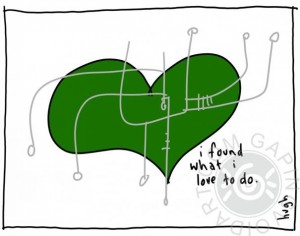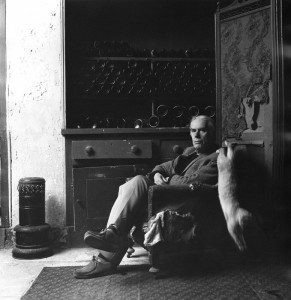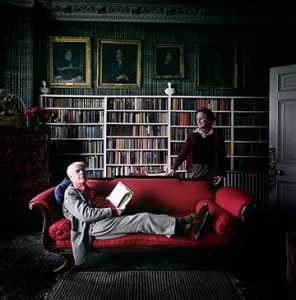 On Friday afternoon I taped an episode of Theater Talk with Ben Brantley of the New York Times, Peter Marks of the Washington Post, and John Simon, who is about to turn ninety. It was fun, but it also felt strange, very much so. I never imagined that I’d become the drama critic of The Wall Street Journal until it happened. Now I’ve been doing it for twelve years, and I just taped a TV show with a colleague whose work I first read when I was in high school. Back then, and for years afterward, I envisioned any number of possible fates for myself. None of them bore the slightest resemblance to the life I lead today.
On Friday afternoon I taped an episode of Theater Talk with Ben Brantley of the New York Times, Peter Marks of the Washington Post, and John Simon, who is about to turn ninety. It was fun, but it also felt strange, very much so. I never imagined that I’d become the drama critic of The Wall Street Journal until it happened. Now I’ve been doing it for twelve years, and I just taped a TV show with a colleague whose work I first read when I was in high school. Back then, and for years afterward, I envisioned any number of possible fates for myself. None of them bore the slightest resemblance to the life I lead today.
 If this story has a moral, it’s that nothing—nothing—is foreseeable. Like the song says, life is pandemonium. The trick, I guess, is to accept amazement as a given, and that’s what I try to do. But it grows harder with every passing year. More and more I feel like one of those characters in the novels of John P. Marquand who suddenly realizes as he passes into middle age that he has no understanding whatsoever of the meaning (if any) of his life.
If this story has a moral, it’s that nothing—nothing—is foreseeable. Like the song says, life is pandemonium. The trick, I guess, is to accept amazement as a given, and that’s what I try to do. But it grows harder with every passing year. More and more I feel like one of those characters in the novels of John P. Marquand who suddenly realizes as he passes into middle age that he has no understanding whatsoever of the meaning (if any) of his life.
Saul Bellow, of all people, reviewed Marquand’s Melville Goodwin USA in Commentary in 1952, four years before I was born and fifty-seven years before I became that same magazine’s critic-at-large. He captured in his review a sliver of what I’ve been feeling lately:
The narrator and sub-hero of Marquand’s novel is a journalist, Sidney Skelton, who becomes a radio news commentator. This happens in a wholly accidental manner; a radio executive is struck by the quality of “sincerity” in his voice, gets him a program, and makes him rich and famous. Quite suddenly Skelton is surrounded by luxury; he owns a large country house, a chauffeur brings him to town, and above the thunder of Manhattan he sits in a leather-upholstered office and talks to the nation. Naturally, he can’t feel that his success is real…
Life changes so swiftly for the successful man, the new is so overpowering, that he can only pretend to know where he is, to know what to do, how to appear, what to say, how to occupy his position.
Unlike Sidney Skelton, I don’t have a chauffeur or a large, luxurious country house, but I do live in an art-filled apartment in upper Manhattan, and there are times when the art seems more real to me than I do. Mrs. T is entirely real, of course, and so are my friends, and once in a while I’m reminded that I’ve done things that have changed the lives of other people for the better. Just the other day I got an e-mail from a performer about whom I wrote a piece many years ago that was, as she put it, a “turning point” in her career. “I will never forget it,” she said. “Thank you for all you have given me.” That was real, too. So is the overflowing shelf of books that I’ve written and edited in the past quarter-century. But what about me? Am I as real as any of these things?
 I suppose I might feel more solidly rooted in the world if, like my brother, I’d had a child somewhere along the way. Instead I’ve had books—and, now, a play and three operas—and I’m proud of them all. I’m proud, too, that I’ve figured out how to earn a living doing all kinds of things that I love to do. I know most of the people in the world aren’t nearly so lucky, and I have the common decency to be grateful for my luck. Yet I find it impossible to understand. I want my life to make more sense than it does. I’d like to be able to look back to a specific moment in my childhood and say, That’s when it all began, and I can’t do it.
I suppose I might feel more solidly rooted in the world if, like my brother, I’d had a child somewhere along the way. Instead I’ve had books—and, now, a play and three operas—and I’m proud of them all. I’m proud, too, that I’ve figured out how to earn a living doing all kinds of things that I love to do. I know most of the people in the world aren’t nearly so lucky, and I have the common decency to be grateful for my luck. Yet I find it impossible to understand. I want my life to make more sense than it does. I’d like to be able to look back to a specific moment in my childhood and say, That’s when it all began, and I can’t do it.
The closest I can come is to remember what it felt like to watch What’s My Line? on TV with my family, an experience that I wrote about in a memoir of my childhood:
For me, it was a ceremony, a mystical rite that opened a window on the unknown world far beyond the city limits of my home town….
The panelists on What’s My Line?, I realized as I watched them week after week, knew each other; they were fellow members of the freemasonry of celebrity, and they convened each Sunday in a television studio in New York, capital of the world, for the sole purpose of entertaining me. As I watched them, I imagined New York to be a place that existed only for the collective pleasure of the rich and famous. To live in New York, I felt certain, was to go to opening nights on Broadway, eat at inconceivably fancy restaurants, appear on What’s My Line?, and be friends with lots of other famous people. I could not imagine living there myself, but it was enough to watch What’s My Line? and dream, and I did plenty of both.
And now…here I am. Not rich, not famous, but most definitely a New Yorker, one who sits on the aisle instead of merely dreaming about it and—every once in a while—pops up on TV. Not on What’s My Line?, though, for it was canceled by CBS in 1967, seven years before I pulled up stakes and left Smalltown, U.S.A., to begin the impossible journey from there to here and then to now.
* * *
The original cast of The 25th Annual Putnam County Spelling Bee sings “Pandemonium,” by William Finn:
The final episode of the original network run of What’s My Line? John Daly is the host and the panelists are Martin Gabel, Arlene Francis, Steve Allen, and Bennett Cerf. I watched this episode when it aired in 1967:

 I wasn’t aware that Anthony Powell had gotten on the bandwagon until
I wasn’t aware that Anthony Powell had gotten on the bandwagon until  I have long been a
I have long been a 
